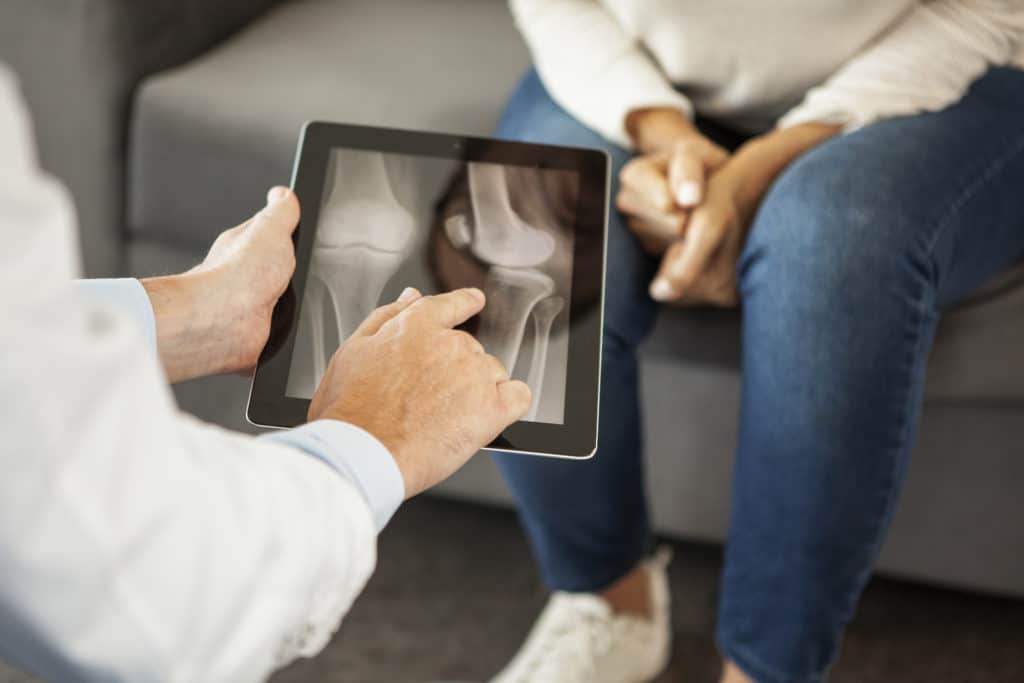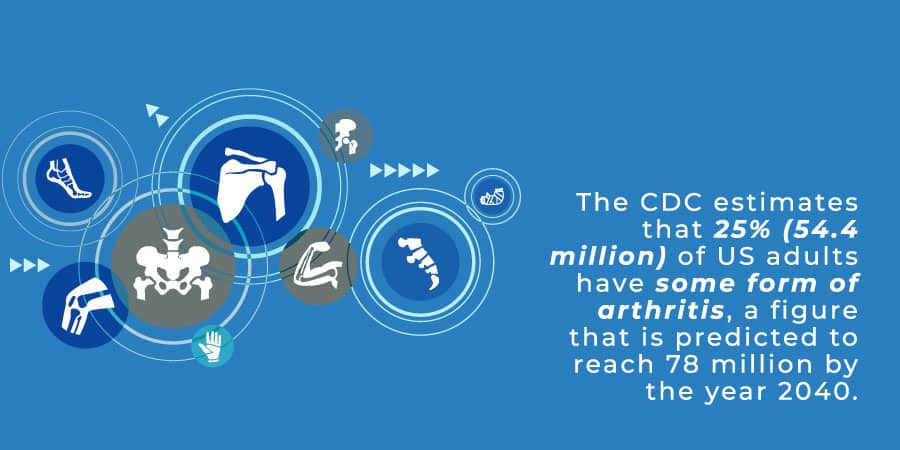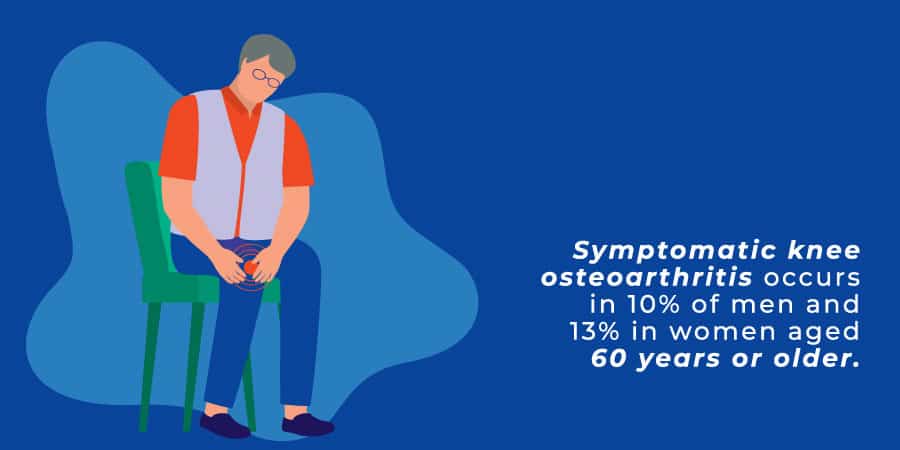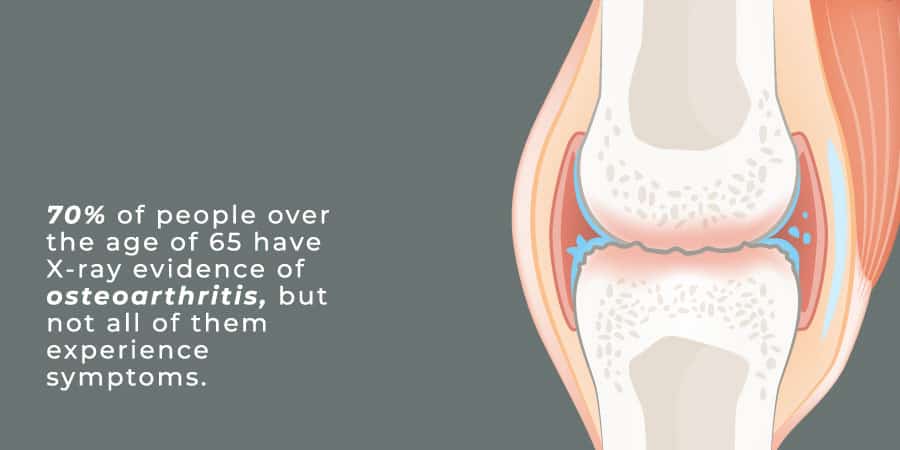
What Is Osteoarthritis?
What Is Osteoarthritis?
Learn about osteoarthritis, the subsequent symptoms, and available treatment options.
Table of Contents
Osteoarthritis: A Prevalent Joint Disease
The most prevalent joint disease is osteoarthritis. Other terms used to describe osteoarthritis are wear-and-tear arthritis and degenerative joint disease.1
A joint is the point wherein two bones in the body meet, and the protecting layer of tissue surrounding the ends of bones is called cartilage. Joint diseases affect these parts of the body and prevent them from working smoothly and efficiently. Osteoarthritis (OA) is a disease in which cartilage breaks away, causing the bones to rub together.2
Let’s discuss what osteoarthritis is and what can be done to treat it.
What Is Osteoarthritis?
A person may suspect they have osteoarthritis if they notice some of its many symptoms, such as serious joint pain or stiffness, a lack of flexibility and ability to move, or tenderness. Discomfort when pressing down on the impacted areas and serious inflammation are also common symptoms caused by this joint disease.3
Osteoarthritis joint pain is perhaps the most indicative sign that a person has the disease. In addition, the pain may intensify as the OA advances and could cause serious swelling in the joints and the areas surrounding them.
Learning More about Osteoarthritis
What Happens in Osteoarthritis?

Cartilage is a smooth tissue inside the body that covers the ends of bones and pads to protect them. Alongside protecting the bones, an important function of cartilage is allowing bones to glide easily with each bodily movement.
With osteoarthritis, the cartilage breaks down and turns into tough, painful tissue. In severe osteoarthritis, the cartilage will rub away entirely, causing the bones to rub together directly. Many parts of the body are affected by OA, including the lining of the joints (synovium), tendons and ligaments, meniscus in the knees, bones, and cartilage.
All of this leads to the serious pain and discomfort one feels when they are suffering from osteoarthritis.4
Who Gets Osteoarthritis?
Osteoarthritis is the second most common disease associated with disability, meaning that the likelihood of developing this disease increases in those with a primary disability. Although the causes vary from person to person, some are more prone to getting OA than others.
For instance, joint injuries can develop into osteoarthritis if left untreated. This is why it’s important always to treat injuries properly and follow up on the recommended treatment suggested by a medical professional.
If someone is born with an abnormal joint structure, they face an increased chance of osteoarthritis forming—a common cause of the disease. The same is true for people born with genetic defects in their joints and cartilage.
Osteoarthritis Symptoms
The most common signs and symptoms of osteoarthritis are listed below.5
- Joint Pain: Joint pain is the most common symptom of osteoarthritis. The affected areas of the body, including the joints and ligaments, will hurt during or after movement, ranging from mild to severe.
- Stiffness in the Joints: Joint stiffness is usually most noticeable after just waking up or being inactive for a long time.
- Loss of Flexibility: Because of the pain and stiffness throughout the body, loss of flexibility is common in OA.
- Tenderness or Discomfort: Tenderness or discomfort in and around the joints, even with a gentle or light touch, is another symptom.
- Crepitus: Crepitus is a grating or creaking sound caused by the bones rubbing together due to the absence of cartilage. Any movement involving the bones sliding alongside each other can create a sound because nothing is left to protect them.
Cause of Osteoarthritis
Age
Osteoarthritis can indeed happen to people at any age, but the likelihood greatly increases in people fifty years old and over. Additionally, it is also more common in older women than it is in older men.
Weight
Extra weight puts stress on the bones and joints, especially the weight-bearing joints throughout the body, such as the knees. Further, fat tissue creates harmful proteins that can produce inflammation in and around joints.
History of Injury or Surgery to a Joint
This is one of the most common reasons a younger person may develop osteoarthritis. Previous injuries, like those caused by sports or physical activity, can increase the risk of this disease. Note that OA still has a chance of forming even if the injury was from years ago.
Overuse from Repetitive Movements of the Joint
A lot of jumping, moving, and twisting can impact the joints in the body over time. Repetitive stress in certain parts of the body or the joints could cause osteoarthritis.
Joints That Do Not Form Correctly
There is a chance that some joints will not grow or form correctly. When this happens, it can be a leading cause of osteoarthritis. Thankfully, when this happens, it can be caught early in a child’s life, and doctors can often be able to repair this through therapy or procedures.
Family History of Osteoarthritis
Many people inherit genetics that increases the chances of getting OA at one point in their lives. Thus, it is possible to have a genetic predisposition toward osteoarthritis.
Metabolic Diseases
Diabetes is just one of the conditions that can cause osteoarthritis due to the increased amounts of iron produced in the body. This occurrence is called hemochromatosis and is a common cause of joint disease.
Getting a Better Understanding
Complications of Osteoarthritis

There are quite a few complications that can arise from having osteoarthritis, such as physical and mental difficulties.
Poor sleep is one of the most common and well-known complications of this joint disease. This is because the pain and stiffness can be felt throughout the body, including when a person is resting. Sleeping does not provide much relief from the disease, which leads many people to lose a lot of sleep.
Another complication is an increase in weight. When people are not able to move freely, they are prone to be sedentary and not move as often as they should, causing weight gain.
The erosion of the ligaments and the tendons in the body can also occur due to this disease. Hairline or stress fractures throughout the body or bleeding near the joint areas (hemarthrosis) may also happen more frequently.
Osteonecrosis, or “Bone Death”
Osteonecrosis, also known as avascular necrosis (AVN) or “bone death,” is a lack of blood supply to bones inside joints. Bones continually replace themselves; however, the limited amount of blood in areas affected by AVN causes bones to deteriorate faster than the body can replace them. Thus, breaking down the bone, causing it to die.
Emotional Repercussions
Emotional complications can arise from osteoarthritis. For example, anxiety and depression can be brought on by a lack of function, loss of bodily use, and pain. Therefore, patients should receive mental health treatment alongside traditional OA treatments (e.g., medication, physical therapy) to combat and relieve both the mental and physical pain caused by osteoarthritis.
Severe Osteoarthritis
Like other progressive conditions, osteoarthritis has five stages ranging from zero to four. The first stage includes typical joint pain and is sometimes hard to notice and diagnose. Meanwhile, stage 4 of OA is very severe; however, the disease usually stabilizes before it reaches the last stage.

Symptoms of Severe Osteoarthritis
People who suffer from severe osteoarthritis are known to have extensive or total loss of their cartilage in parts of their body, especially the joints. Because of the bone-on-bone friction that comes from the disease, this can lead to other symptoms, such as:
- Swelling and Inflammation: Patients will experience more intense swelling and inflammation with severe osteoarthritis. Cartilage damage causes an increased production of synovial fluid, a thick liquid that reduces friction and lubricates joints. The increased fluid in the affected area causes swelling and further pain in and around joints.
- Increased Pain: Any type of movement further increases tenderness, stiffness, and pain. The wear and tear brought upon daily movement can become so severe that the body experiences pain even during rest and nonmovement.
- Lacking Range of Motion: The stiffness and pain throughout many joints in the body will make it much harder to move. Severe osteoarthritis can cause an unwillingness to move to prevent further pain. This can progress as the disease worsens, leaving the patient with a limited range of motion.
- Joint Instability: Joint instability is a sudden lack of movement or locking in the joints, especially buckling in the knees. This can lead to other injuries due to falling, trying to catch oneself when falling, and so on.
Osteoarthritis Prevention
There are some risk factors associated with osteoarthritis that one cannot prevent, such as hereditary factors and congenital disabilities. Genetics cannot necessarily be changed; however, there are some measures that can be taken to prevent or decrease the risk of developing OA.
Support Your Body
Taking care of the body can go a long way. This is especially important for those who partake in a lot of physical activity, such as sports and exercise.
Preventative measures can include wearing and using proper athletic supports and gear to reduce the impact and strain on the joints and knees. For instance, there are many shoes on the market that are specifically designed to provide comfort, stability, and safety to the knees and joints throughout the body.
Maintain a Moderate Weight
Of course, staying fit and healthy is a great way to avoid many different diseases, especially osteoarthritis. Extra weight can cause undue and unneeded stress on the body and joints, increasing the likelihood of developing the joint disease.
Eat a Nutritious Diet
A part of being healthy and maintaining the right weight range is eating a healthy, nutritious diet. Aim to have a diet full of healthy foods, such as fruits, vegetables, and protein. Also, incorporate food that promotes healthy bone growth.
Get Enough Rest
Getting enough sleep is a very important way to avoid osteoarthritis. This allows the body to rest after a long day of physical activity and allows the bones and joints to regain health and energy for the next day.
Learning to Overcome Osteoarthritis
Treatments for Osteoarthritis at J. Flowers Health Institute

At J. Flowers Health Institute, we have treatment options that cater to patients with osteoarthritis. Our goal is to help manage the symptoms and prevent the disease from taking over your life.
Medications
The primary objectives of OA medications are to ease joint inflammation and pain. Nonsteroidal anti-inflammatory drugs (NSAIDs), such as ibuprofen (Motrin, Advil) and naproxen (Aleve), are the most common medications prescribed to treat pain and inflammation caused by osteoarthritis.
For mild to severe discomfort, over-the-counter pain medications are effective. Doctors can prescribe more intense forms of NSAIDs for more severe pain. There are also gels and lotions offered that may have fewer adverse effects than most other oral drugs.
Exercise
Exercise, such as jogging, walking, stretching, or even running, is important for treating osteoarthritis.
Hot and Cold Therapies
Cold and hot therapies are often prescribed for OA because they can relieve the stress and pain of inflammation within the body’s joints. Typically, the patient will oscillate between the two based on a schedule given by the doctor or physical therapist.
Surgery
A few routes can be taken if the doctor believes surgery is the best treatment option. The most common is joint replacement surgery, usually employed when someone has severe OA. This is when the damaged joints within the body are replaced by synthetic ones.
Hip replacement surgery is another popular medical procedure similar to the one previously mentioned. Other common procedures associated with osteoarthritis relief include injunctions of cortisone and lubrication.
Fortunately, solutions and treatments are waiting for you at J. Flowers Health. Contact us today to learn about the first steps to take and how we can help begin your journey to OA relief!
Resources
- https://medlineplus.gov/osteoarthritis.html
- https://www.drugwatch.com/health/arthritis/osteoarthritis/
- https://www.mayoclinic.org/diseases-conditions/osteoarthritis/symptoms-causes/syc-20351925
- https://www.cdc.gov/arthritis/basics/osteoarthritis.htm
- https://www.niams.nih.gov/health-topics/osteoarthritis
- https://www.healthline.com/health/common-causes-osteoarthritis






